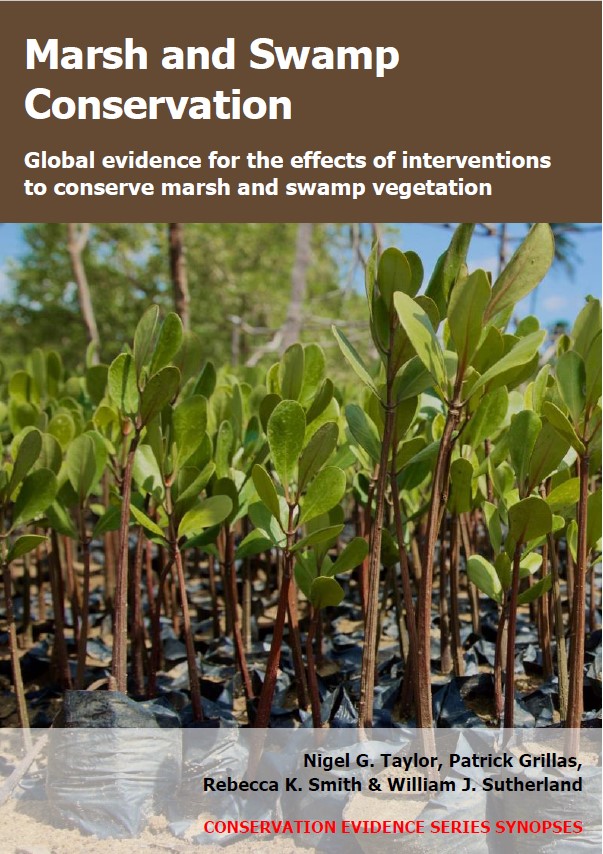Change type of livestock grazing: brackish/salt marshes
-
Overall effectiveness category Likely to be beneficial
-
Number of studies: 3
View assessment score
Hide assessment score
How is the evidence assessed?
-
Effectiveness
40% -
Certainty
45% -
Harms
0%
Study locations
Supporting evidence from individual studies
A replicated, paired, controlled study in 2010–2011 on a salt marsh in the Netherlands (Nolte et al. 2014) found that grazing by horses produced shorter vegetation on average, and larger uniform patches of vegetation, than grazing by cattle. After two summers of grazing, plots grazed by horses contained shorter vegetation stands (12 cm average height) than plots grazed by cattle (15 cm average height). Vegetation patches (i.e. areas of vegetation with uniform height) were larger in horse-grazed plots (190 cm diameter) than in cattle-grazed plots (98 cm diameter). Variation in height amongst patches was statistically similar in horse- and cattle-grazed plots (data reported as statistical model results). Methods: In 2010, eight 11-ha plots were established (in two sets of four) on a coastal salt marsh. The marsh had been “intensively grazed” for the previous 20 years. In May–October 2010 and 2011, four plots (two plots/set) were grazed by horses and four were grazed by cattle. Half of the plots were grazed at high intensity (1.0 animal/ha) and half were grazed at low intensity (0.5 animals/ha). In August 2011, vegetation height was measured along six 25-m transects/plot (100 points/transect). Some or all of the plots in this study were also used in (2) and (3).
Study and other actions testedA replicated, randomized, paired, controlled, before-and-after study in 2009–2013 on a salt marsh in the Netherlands (van Klink et al. 2016) found that grazing by cattle and horses had similar effects on plant species richness, vegetation height and the area of vegetation dominated by sea couch grass Elytrigia atheria. Over four years, plots grazed by cattle and horses did not significantly differ in plant species richness (both 8–14 species/16 m2) or average vegetation height (cattle: 9–22 cm; horses: 10–17 cm). This was true in both near to and far from the sea. Over four years, and across the whole marsh, plots grazed by cattle and horses experienced a statistically similar change in area of couch-grass-dominated vegetation (data not reported). Methods: In 2009, twelve 11-ha plots were established (in three sets of four) on a historically grazed coastal salt marsh. From 2010, six plots (two random plots/set) were grazed in summer by each livestock type: cows or horses. Half of the plots were grazed at high intensity (1.0 animal/ha) and half were grazed at low intensity (0.5 animals/ha). Vegetation height and plant species were recorded in late August/early September 2010–2013, in eight 16-m2 quadrats/plot/year. The area of couch-grass-dominated vegetation was mapped using aerial photographs taken before (2009) and four years after (2013) grazing treatments were applied. Some of the plots in this study were also used in (1) and (3).
Study and other actions testedA replicated, randomized, paired, controlled, before-and-after study in 2009–2013 on a salt marsh in the Netherlands (Lagendijk et al. 2017) found that grazing by cattle and horses had statistically similar effects on plant community composition, plant species richness and two focal herb species. After six years, cattle-grazed and horse-grazed plots contained a similar overall plant community (data not reported) and plant species richness (cattle: 8.4–10.2 species/16 m2; horses: 8.3–10.2 species/16 m2). Over the six years, plots grazed by cattle and horses had experienced a similar turnover of plant species (data reported as a turnover index) and similar increases in plant species richness (cattle: gain of 1.7–5.9 species/16 m2; horses: gain of 1.1–5.2 species/16 m2). They had also experienced similar changes in cover of sea couch grass Elytrigia atheria (cattle: 2–11% change; horses: 0–9% change) and sea aster Aster tripolium (cattle: 1–27% change; horses: 13–15% change). Methods: In 2009, eight 11-ha plots were established (in two sets of four) on a coastal salt marsh. From 2010, four plots (two random plots/set) were grazed in summer by each livestock type: cows or horses. Half of the plots were grazed at high intensity (1.0 animal/ha) and half were grazed at low intensity (0.5 animals/ha). Plant species and their cover were recorded in August/September 2009 (after a summer of intense grazing to standardize plots) and 2010–2015 (during cattle/horse grazing treatments). Surveys were carried out in eight 16-m2 quadrats/plot/year. Some or all of the plots in this study were also used in (1) and (2).
Study and other actions tested
Where has this evidence come from?
List of journals searched by synopsis
All the journals searched for all synopses
This Action forms part of the Action Synopsis:
Marsh and Swamp Conservation
Marsh and Swamp Conservation - Published 2021
Marsh and Swamp Synopsis





)_2023.JPG)














